
~~~~~~~~~~~~~~~~~~~~~~~~~~~~~~~~~~~~~~~~~~~
Live Earth Farm (Com)Post
6th Harvest Week, Winter 2006/2007
February 7th, 2007
~~~~~~~~~~~~~~~~~~~~~~~~~~~~~~~~~~~~~~~~~~~
In this issue
--Greetings from Farmer Tom
--Morris Grassfed Beef
--More pictures from around the farm
--What's in the box this week
--Notes from Debbie's Kitchen
" The land is showing signs of life and deep within
the impulse to participate in the wild play of nature returns."
~ Tom
Greetings from Farmer Tom
~~~~~~~~~~~~~~~~~~~~~~~~~~~~~~~~~~~~~~~~~~~~~~~~

This year I will let Headstart Nursery in Gilroy grow our Pepper and
Eggplant seedlings. It has always been a challenge in our greenhouse,
to maintain the optimum 75-80 degrees Fahrenheit to achieve a uniform
and high rate of germination for these two popular nightshades. I figure
there are enough variables we try to juggle every season and raising pepper
and eggplant seedlings is one variable I don't mind not having to worry
about. The riskiest aspects in farming have to do with timing and
creating just the right conditions for our crops to thrive. Spring is
the season when the stakes of gambling with Mother Nature are the highest.
The seedlings in April have to be healthy and strong for transplanting,
the soil has to have the right tilth and moisture content, and the temperature
should be warm enough for the young transplants to grow. If these conditions
don't match up we typically have a really late crop or worse, a complete
crop failure.
As I was driving to Gilroy to drop off the eggplant and pepper seeds
at Headstart Nursery my concerns about the risk of farming were quickly
put into perspective. An NPR news report about Global Warming confirmed
that the warming trend of our planet is in large part due to human activities,
and as a result will have a significant impact on our climate over the
next century. What seems to be encouraging for me, uncertainty of the
weather aside, is that there is a renewed interest in promoting more
sustainable food production and consumption practices. It is a dream of
mine to see a return to an agrarian culture in this country, one where the
landscape is once again a mosaic of small farms which in turn create a strong
community, honoring skills and resources that have been lost over the last
60 years of industrial farming. Who are the children that will rebuild such
an agrarian culture? What function can we play in nurturing a new culture
of food? What can the Live Earth Farm Community of Members do to seed
hope and inspiration as we enter into a new era of uncertainty? As I reflect
on these things I also feel grateful, as a Farmer, to have the opportunity
to raise these questions. Much of my reflections stem from the inspiration
that comes from the commitment and support I feel from all of you! –
Tom
<back to top>
Morris Grassfed Beef
~~~~~~~~~~~~~~~~~~~~~~~~~~~~~~~~~~~~~~~~~~~~~~~~
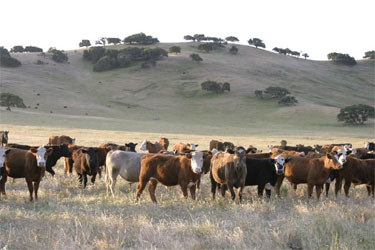
Hi folks, it’s Debbie – If you are an omnivore in search
of a source of healthy, grassfed, grass-finished beef for your family,
search no further. Joe and Julie Morris, of T&O Cattle Company down
in San Juan Bautista are your answer. I have gotten my own beef from
them for several years now (so have many other CSA members) and can attest
to the quality of the meat and the integrity of the Morrises, who raise
the animals and steward the land. As Julie will tell you, “Our
cattle enjoy a completely organic diet of fresh grass, forbs and legumes,
clean water, and better views than most of us do! We use neither synthetic
hormones nor fed antibiotics: our animals grow only as fast as their
genetics and the range will allow. Their range, of course, serves also
as watersheds and habitat for us as well as other biological communities.
We manage our animals so that they enhance the diversity of life on the
range, as well as the quality of the water that falls on the range and
flows to the towns and sea. We believe this web of relationships we are
stewarding is an integral whole, depending for its health upon all its
members: damaging the health of any member of the "whole" community,
therefore, damages the rest. Our desire is to produce health with all
we do. Only when this is done are we satisfied that Morris Grassfed Beef
is all it can be—the best there is for all of us.” Also,
all their Morris Grassfed beef cattle are born and raised by them on
their ranch in San Juan Bautista; they do not purchase calves and then
just finish them on grass. The animals are under Joe and Julie’s
care from birth to the time the meat is delivered to you.
Here are a few factoids about eating meat from pastured animals, as
gleaned from Michael Pollan’s book, “The Omnivore’s
Dilemma”: • A growing body of scientific research suggests
that many of the health problems associated with eating beef are really
problems with corn-fed beef. Cattle are ruminants, not designed to eat
grain (organic or not). It makes them sick. This is why most of the antibiotics
sold in America today end up in animal feed. The research further indicates
that pasture substantially changes the nutritional profile of chicken,
eggs, beef and milk. • The large quantities of beta-carotene, vitamin
E, and folic acid present in green grass find their way into the flesh
of the animals that eat that grass. • The fats created in the flesh
of grass eaters are the best kind for us to eat. Grass-fed meat, milk,
and eggs contain less total fat and less saturated fats than the same
foods from grain-fed animals. Pastured animals also contain conjugated
linoleic acid (CLA), a fatty acid that some recent studies indicate may
help reduce weight and prevent cancer, and which is absent from feedlot
animals. But perhaps most important, meat, eggs, and milk from pastured
animals also contain higher levels of omega 3s, essential fatty acids
created in the cells of green plants and algae that play an indispensable
role in human health, and especially in the growth and health of neurons – brain
cells.
In a nutshell, the species of animal you eat may matter less than what
the animal you’re eating has itself eaten!
I just talked to Joe Morris this morning about his upcoming season,
and thought that those of you who don’t already know about this
great resource might be interested in learning more. Joe is going to
try something a little different this year. In the past, you would order
your meat and pick it up once a year, in the summer. The smallest quantity
you can order is a ‘split half,’ which is essentially a quarter
of a beef steer, or roughly 85 pounds of meat in the form of steaks,
roasts, ground beef and stew meat – enough meat so that an average
family can enjoy healthful grassfed beef year round. But Joe realized
that not everyone has the freezer capacity for all that meat at one time,
and that perhaps some people who otherwise would want to purchase his
beef might be unable to because of this. As a result, Joe has decided
to offer the meat CSA style – i.e. you can sign up for a ‘split
half’ but then take delivery of your meat quarterly, instead of
all at one time. That way, you wouldn’t have to set aside as much
of your own freezer space to store it because Joe would keep it all in
his own big freezer for you, and then deliver one quarter of your share
to you in Summer, Fall, Winter and Spring. (He has his own drop-off locations,
much like our CSA does.)
If you are interested, I suggest you email Joe and Julie at info@morrisgrassfed.com,
tell them I sent you, and ask to be put on their elist. [You will not be
bombarded by email from them – they only email their customers a
couple times a year.] They will be sending out order forms soon to people
on that elist, and they do sell out, so if you’re thinking about
it, it doesn’t hurt to get yourself ‘into the loop.’ Just
being on their elist does not obligate you in any way. They also have a
very nice website if you’d like to browse that before contacting
them. Go to www.morrisgrassfed.com.
You won’t be disappointed.
- Debbie
<back to top>
More pictures from around the farm
~~~~~~~~~~~~~~~~~~~~~~~~~~~~~~~~~~~~~~~~~~~~~~~~
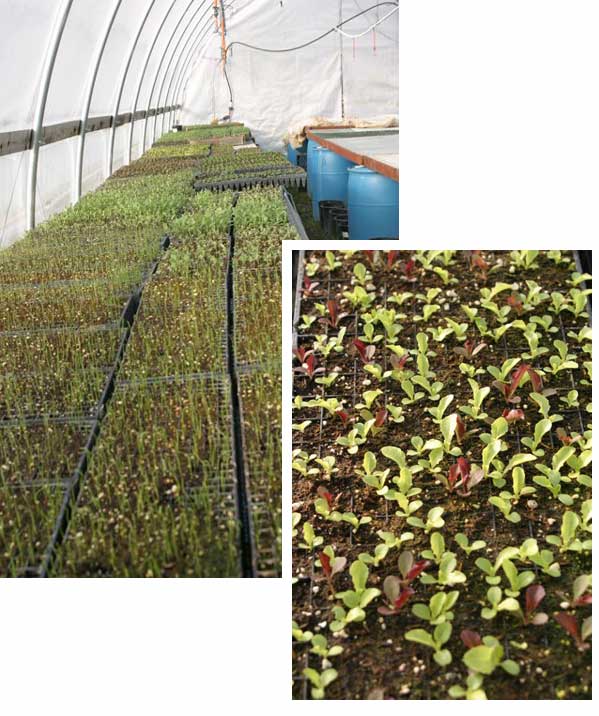
The Live Earth Farm greenhouse - where it all (mostly) begins!
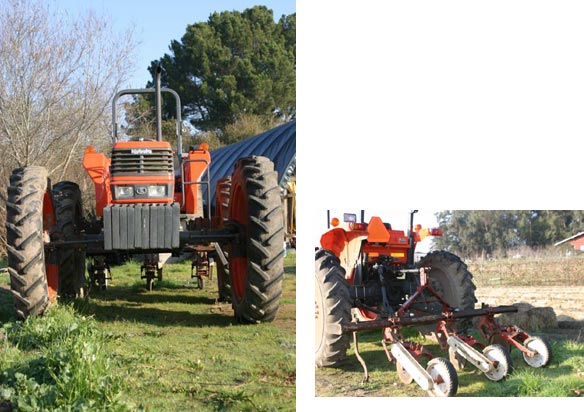
Our big Kubota tractor, shown at right with the green bean planter
attachment; no we're not planting green beans in February - we're taking
advantage of the good winter weather to service the equipment in prepration
for spring planting.
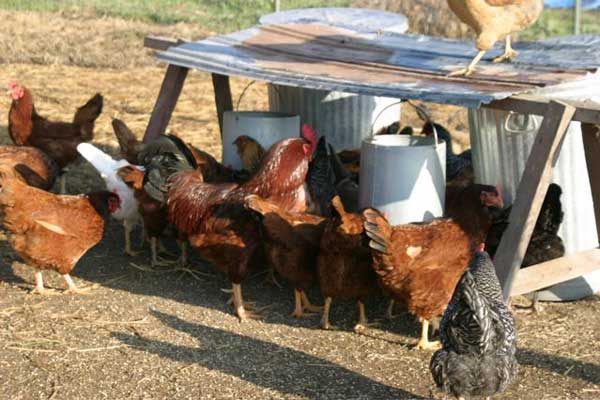
Some of Live Earth Farm's chickens. The flock is soon to be added to
as we will be taking delivery of 60 new chicks any day now. Tom's niece
Bernadette, here for the season from Germany (via Scotland!) is interning
at the farm, and will be managing the new flock. These
are the birds that will eventually be rotationally grazed on our new
chicken pasture (see picture Week 4). In addition to creating happy chickens
and nutritious eggs, Tom will be experimenting with using chickens as
weed abatement. They may get rotated through other areas of the farm
over time (in the swales or the orchards, for example) to eat down the
weeds, and fertilize at the same time!
<back to top>
What's in the box
~~~~~~~~~~~~~~~~~~~~~~~~~~~~~~~~~~~~~~~~~~~~~~~~
2 lbs. apples (Billy Bob’s Orchard)
1 bag brussel sprouts (Lakeside Organic Gardens)
1 head green cabbage
1 bunch carrots
1 purple cauliflower
2 bunch chard
1 bunch kale
1 bu. rutabagas, w/greens
3 acorn squash (Lakeside Organic Gardens)
<back to top>
Notes from Debbie's Kitchen
~~~~~~~~~~~~~~~~~~~~~~~~~~~~~~~~~~~~~~~~~~~~~~~~
More recipes this week (I know I didn’t have so many last time!). I still haven’t received my fermenting crock (grrr!), so the recipes for fermented veggies will have to wait. First, a repeat of a recipe I’ve run before for acorn squash (back in 2004, so I feel it’s okay to use again!) but – this time I scanned the photo to share with you. This is why I want to try this (it looks so good!). The rest of the recipes are all from my clipping file (or my imagination). Anything in square brackets [like this] is me putting in my two cents. - Debbie
Acorn Squash rings with Honey-Soy Glaze
from an undated Bon Appetit clipping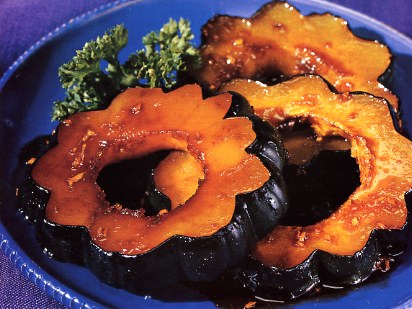
(modified slightly) serves 4
Nonstick veggie oil spray [or just some oil]
2 acorn squash
3 tbsp. honey
1 tbsp. soy sauce
2 tsp. rice vinegar
1 1/2 tsp. minced peeled fresh ginger
1 garlic clove, minced
Preheat oven to 450 degrees F. Line a large baking sheet with foil. Spray with
nonstick spray [or brush lightly with oil]. Cut off both ends of each squash,
then cut them crosswise into 4 rings each. Scoop out seeds and discard. Place
squash rings in a single layer on prepared baking sheet, cover tightly with
foil and bake until squash begins to soften, about 15 minutes.
Meanwhile, whisk next 5 ingredients in a small bowl to blend. Remove foil from
squash and brush half the mixture over squash. Sprinkle with salt and pepper.
Bake uncovered 10 minutes. Brush remaining mixture over squash and continue
to bake until squash is brown, tender and glazed, about 10 more minutes.
Cauliflower with Mustard-Lemon Butter
another undated Bon Appetit clipping
serves 6
1 sm. head cauliflower [purple or white. This will probably be really nice
with purple, as the acid from the lemon juice tends to kick up the color of
the cauliflower]
1 tsp. coarse kosher salt [or coarse sea salt, or whatever you have]
6 tbsp. butter
2 tbsp. fresh lemon juice [juice from half a lemon]
2 tbsp. whole grain Dijon mustard [or just regular Dijon if you don’t
have the grainy type]
1 ½ tsp. finely grated lemon peel
1 tbsp. chopped fresh parsley
Preheat oven to 400 degrees F. Butter a rimmed baking sheet. Cut cauliflower
in half, then crosswise into ¼ inch thick slices. Arrange slices in
a single layer on prepared baking sheet; sprinkle with salt. Roast until cauliflower
is slightly softened, about 15 minutes.
Meanwhile, melt butter in small saucepan over medium heat. Whisk in lemon juice,
mustard, and lemon peel.
Spoon mustard-lemon butter evenly over cauliflower and roast until crisp-tender,
about 10 minutes longer. Transfer cauliflower to a platter and sprinkle with
parsley. Serve warm or at room temperature.
Cabbage Soup with Apples and Thyme
by Mark Bittman
4 to 6 servings
3 tbsp. butter
1 tbsp. olive oil
8 C thinly sliced cored green cabbage (about ½ large head)
1 lg. onion, chopped
8 lg. fresh thyme sprigs [or if you don’t have that, just some
dried thyme; maybe ¼ tsp. Thyme is pretty potent, like rosemary.]
6 C chicken broth [preferably your own homemade!]
1 ¼ lbs. apples, peeled, cored, cut into ½-inch cubes
Chopped fresh thyme [if you have it, for garnish]
Melt 1 tbsp. butter with oil in a heavy large pot over medium-high heat. Add
cabbage and onion; sauté until vegetables wilt and brown, stirring occasionally,
about 15 minutes. Add the thyme sprigs [or dried thyme] and sauté a
minute longer. Add broth and bring to a boil. Reduce heat to medium and simmer
5 minutes. Season to taste with salt and pepper.
Melt remaining 2 tbsp. butter in a heavy large skillet over medium-higih heat.
Add apples and sauté until brown and tender, stirring occasionally,
about 12 minutes. Season with salt and pepper.
Remove thyme sprigs [if used] from soup. Ladle soup into bowls; garnish with
apples and chopped fresh thyme and serve. [Obviously if you don’t have
the fresh thyme, just skip this step, not the whole recipe!]
Rutabaga Puree with Cardamom and Thyme
yet another Bon Appetit clipping [My mom’s been giving me a subscription
to this for years, so I’ve always gleaned the recipes that appealed to
me and then recycled the rest of the magazine!]
Hmm, this recipe says ‘serves 12’ and is made with 6 lbs. of rutabagas...
I think I’ll try to scale it down to what we’re getting! It’ll
probably serve more like 2 to 4.
1 bu. fresh farm rutabagas (Tom says there should be about six), peeled, and
cut into 1-inch cubes
¼ tsp. coarse kosher salt [ditto about the salt, as I mentioned above
in the Cauliflower recipe]
8 whole green cardamom pods [I’d smash the pods a little with the side
of a heavy flat knife, to release their flavor better]
2 tbsp. C creme fraiche [or heavy cream, or maybe plain yogurt]
1 tbsp. chopped fresh thyme
Freshly ground white pepper
Place rutabagas in a pot with enough cold water to cover by an inch. Add salt
and cardamom pods; bring to a boil. Reduce heat, cover partially, and simmer
until rutabagas are tender [pierce easily with a sharp knife], about 15 minutes.
Drain rutabagas; discard cardamom pods. Working in batches if necessary, purée
rutabagas in a food processor. Return puree to pot. Cook over medium heat until
dry, stirring, a few minutes. Mix in creme fraiche and thyme. Season with salt
and white pepper.
Chilled Chard with Soy and Sesame
from an April 2000 SJ Mercury News clipping
serves 4 as a first course
2 ½ lbs. chard leaves, thick ribs discarded [better yet, save the stems
and use in a different recipe, or at least compost them!]
Salt
1 tbsp. soy sauce
1 tsp. sugar
1 tsp. toasted sesame oil
1 tsp. sesame seeds, toasted in a dry skillet until golden
Wash chard leaves, shake to remove excess water and roughly chop. Place in
a stockpot, sprinkling lightly with salt as you add leaves. Turn heat to medium,
cover and cook, stirring occasionally until wilted, about 10 minutes [I think
it’ll take less time than that]. Transfer to a colander set over a bowl,
and cool to room temperature.
Meanwhile, bring soy sauce, sugar and sesame oil to a boil in a small saucepan.
Simmer just until sugar dissolves. Set aside to cool.
When chard has cooled, pick it up and squeeze it with your hands, removing
as much liquid as possible. Transfer to a bowl, drizzle with soy mixture, and
toss to season evenly. cover and refrigerate until chard is well chilled, up
to several hours.
To serve, transfer chard to a serving bowl and sprinkle with toasted sesame
seeds.
Glazed Carrots with Molasses and Marjoram
yet another undated Bon Appetit clipping!
modified [original recipe served 12] to serve 4
Note: this recipe uses fresh marjoram; if you don’t have your own herb
garden or aren’t in a position to shop for fresh herbs at the market,
I’m going to suggest dried herb substitutions. But this recipe does sound
like it’d be better if you could get ahold of fresh marjoram! – Debbie
1 large fresh marjoram sprig [or about ¼ tsp. dried]
1 tbsp. unsalted butter
½ tbsp. olive oil
1 lb. carrots, peeled, halved lengthwise, cut crosswise into 1 ½ inch
lengths
2 tbsp. fresh orange juice
2 tbsp. water
1 tbsp. mild-flavored (light) molasses [ah, don’t listen to ‘em – I
love blackstrap!]
½ tbsp. chopped fresh Italian parsley
Remove leaves from marjoram sprig. Chop enough to measure ½ tsp. Reserve
stems [if using fresh]. Melt butter with oil in a large skillet over medium-high
heat. Add carrots; season with salt and pepper. Toss with tongs until evenly
coated and sizzling, about 3 to 4 minutes. Add orange juice, water, molasses
and marjoram stems [again, if using. If you’re going the dried marjoram
route, I’d add it here]. Reduce heat to medium-low. Cover and simmer
until carrots are almost tender, about 6 minutes. Uncover; increase heat to
high and boil until juices are reduced to syrup and carrots are tender, a few
minutes more. Discard marjoram stems [if used]. Add parsley and chopped fresh
marjoram [don’t add more marjoram if you’re going the dried route];
toss to coat. Season to taste with salt and pepper.
Debbie’s Roast Cauliflower Lemon “Spaghetti”
Actually I don’t know what to call this; I made it up for dinner the
other night and it was really tasty. The combination may sound weird, but it
was yummy!! All I did was:
1. roast the cauliflower (coating it with a little olive oil, then sprinkling
it with salt, pepper and turmeric; spread it on a foil-lined pan and then roasting
it for 20 minutes or so in a 425 degree oven);
2. make a ‘spaghetti sauce’ with Italian-style sausage (I made
my own sausage by taking a package of Morris Grassfed ground beef and mixing
in salt, garlic, fennel seed, crushed red chilies, dried basil and a little
oregano). Sauté up some onion in a generous amount of olive oil then
add the sausage and brown it, then add crushed or chopped or puréed
tomatoes (home-canned, if you have them!), maybe a little more basil, maybe
a splash of red wine if you have an open bottle... simmer it down to a consistency
that makes you happy;
3. serve the sauce atop the roasted cauliflower, then top it with a generous
grating of fresh parmesan, a pretty sprinkling of minced fresh Italian parsley
and some finely grated lemon zest.
Something about the aromatic lemon zest added at the end links back to the
turmeric added in the beginning and it all just works. I don’t know how
I come up with these things sometimes; often it is just a function of being
dinnertime and I need to make something for dinner, so I just look in the fridge
or freezer and see what I have to work with. But when the end result tastes
good, I’m happy to share the idea with you all! And of course I welcome
your own ideas if you’re willing to share them as well.
<back to top>
Contact Information
~~~~~~~~~~~~~~~~~~~~~~~~~~~
email: farmers@cruzio.com
phone: 831.763.2448
web: http://www.liveearthfarm.net
~~~~~~~~~~~~~~~~~~~~~~~~~~~